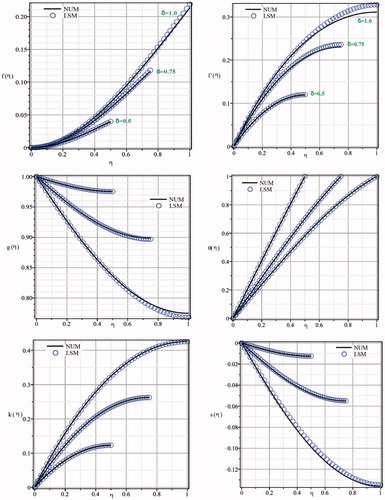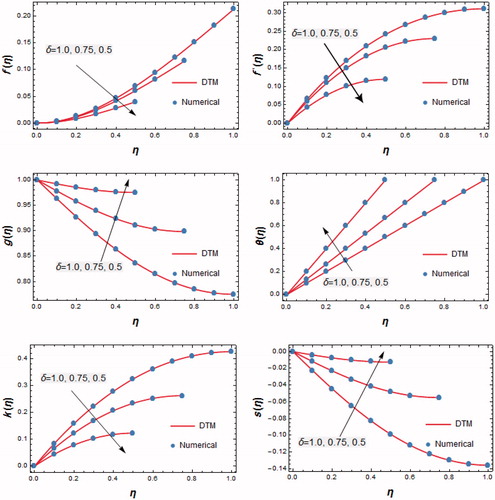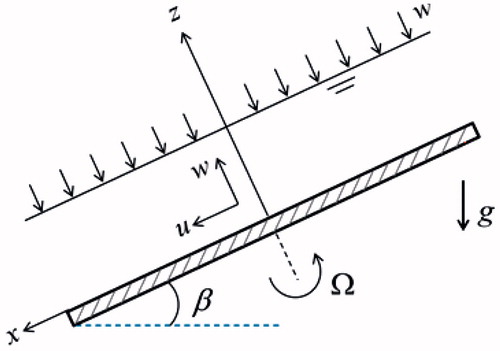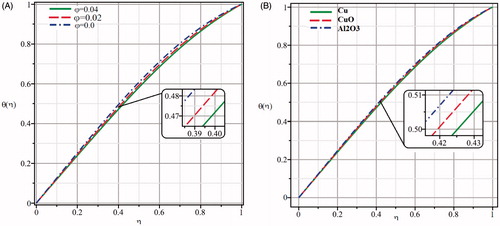Abstract
In this study, least square method (LSM) and differential transform method (DTM) applied to solve the three dimensional problem of steady nanofluid deposition on an inclined rotating disk is illustrated. The governing non-linear partial differential equations are reduced to the nonlinear ordinary differential equations system by similarity transform. There is a good agreement between the present analytical and numerical results. Results indicate that increasing nanofluid volume fraction leads to increase in temperature profile and highest temperature obtained for aluminium oxide (Al2O3)-water case.
1. Introduction
The removal of a liquid condensate from a cooled, saturated vapor is important in chemical and mechanical engineering processes. Many researchers illustrated this problem at the different conditions. Sparrow and Gregg (Citation1959) studied the removal of the condensate using centrifugal forces on a cooled rotating disc. Sparrow and Gregg (Citation1959) transformed the Navier-Stokes equations into a set of nonlinear ordinary differential equations and numerically integrated for the similarity solution for several finite film thicknesses. The problem is also related to chemical vapor deposition, when a thin fluid film is deposited on a cooled rotating disk (Jensen, Einset, & Fotiadis, Citation1991).
Enhancement of heat transfer performance in these systems is an essential topic from an energy saving perspective. The low thermal conductivity of conventional heat transfer fluids such as water and oils is a primary limitation in enhancing the performance and the compactness of such systems. Solid typically has a higher thermal conductivity than liquids. For example, copper (Cu) has a thermal conductivity 700 time greater than water and 3000 greater than engine oil. An innovative and new technique to enhance heat transfer is by using solid particles in the base fluid (i.e. nanofluids) in the range of sizes 10–50 nm. Khanafer, Vafai, and Lightstone (Citation2003) firstly conducted a numerical investigation on the heat transfer enhancement by adding nano-particles in a differentially heated enclosure. They found that the suspended nanoparticles substantially increase the heat transfer rate at any given Grashof number. Rashidi, Abelman, and Mehr (Citation2013) considered the analysis of the second law of thermodynamics applied to an electrically conducting incompressible nanofluid fluid flowing over a porous rotating disk. They concluded that using magnetic rotating disk drives has important applications in heat transfer enhancement in renewable energy systems. Ellahi (Citation2013) studied the magnetohydrodynamic (MHD) flow of non-Newtonian nanofluid in a pipe. He observed that the MHD parameter decreases the fluid motion and the velocity profile is larger than that of temperature profile even in the presence of variable viscosities. Free convection heat transfer in a concentric annulus between a cold square and heated elliptic cylinders in presence of magnetic field was investigated by Sheikholeslami, Gorji-Bandpy, and Ganji (Citation2013a). They found that the enhancement in heat transfer increases as Hartmann number increases but it decreases with increase of Rayleigh number. Asymmetric laminar flow and heat transfer of nanofluid between contracting rotating disks was investigated by Hatami, Sheikholeslami, and Ganji (Citation2014). Their results indicated that temperature profile becomes more flat near the middle of two disks with the increase of injection but an opposite trend is observed with increase of expansion ratio. The problem of laminar nanofluid flow in a semi-porous channel in the presence of transverse magnetic field was investigated analytically by Sheikholeslami, Hatami, and Ganji, (Citation2013b). Their results showed that velocity boundary layer thickness decrease with increase of Reynolds number and it increase as Hartmann number increases. Khan and Pop (Citation2010) published a paper on boundary-layer flow of a nanofluid past a stretching sheet. They indicated that the reduced Nusselt number is a decreasing function of each dimensionless number. Hassani, Tabar, Nemati, Domairry, and Noori (Citation2011) investigated the problem of boundary layer flow of a nanofluid past a stretching sheet. They found that the reduced Nusselt number decreases with the increase in Prandtl number for many Brownian motion numbers. Rashidi and Dinarvand (Citation2009) investigated the steady three-dimensional problem of condensation film on inclined rotating disk by analytical methods introduced by Aziz (Citation2006) using Maple software where Bhatti and Zeeshan (Citation2017), Bhatti, Zeeshan, and Ellahi (Citation2016, Citation2017a), Bhatti, Zeeshan, Ellahi, and Ijaz (Citation2017b), Ezzat (Citation1994, Citation2001, Citation2011, Citation2012), Ezzat and Youssef (Citation2010), Hatami and Ganji (Citation2014a, Citation2014b), MA. Ezzat, El-Bary, and SM. Ezzat (Citation2013); MA. Ezzat, Abbas, El-Bary, and SM. Ezzat (Citation2014a), M. Ezzat, Sabbah, El-Bary, and S. Ezzat (Citation2014b), Nawaz, Hayat, and Zeeshan (Citation2016), Othman and Ezzat (Citation2001), Zeeshan, Hassan, Ellahi, and Nawaz (Citation2016), Zeeshan and Majeed (Citation2016a, Citation2016b), and some recent researchers (Devakar, Ramesh, Chouhan, & Raje, Citation2017; Mahanthesh, Gireesha, & Gorla, Citation2017; Mirgolbabaee, Ledari, & Ganji, Citation2017; Saleh, Alali, & Ebaid, Citation2017; Srinivasacharya & Shafeeurrahman, Citation2017) used these valuable methods for analyzing the heat transfer and nanofluid flow problems in different geometries.
In this work we shall develop and apply least square method (LSM) and differential transform method (DTM) to solve the problem of three-dimensional analysis of condensation nanofluid film on an inclined rotating disk.
2. Flow analysis and mathematical formulation
(Rashidi & Dinarvand, Citation2009) shows a disk rotating in its own plane with angular velocity Ω. The angle between horizontal axis and disk is β. A nanofluid film of thickness h is formed by spraying, with the W velocity. We assume the disk radius is large compared to the film thickness such that the end effects can be ignored. Vapor shear effects at the interface of vapor and fluid are usually unimportant. The gravitational acceleration, , acts in the downward direction.
The temperature on the disk is Tw and the temperature on the film surface is T0. Besides, the ambient pressure on the film surface is constant at p0 and we can safely say the pressure is a function of z only.
The nanofluid is a two component mixture with the following assumptions: incompressible; no-chemical reaction; negligible radiative heat transfer; nano-solid-particles and the base fluid are in thermal equilibrium with no slip between them. The thermo physical properties of the nanofluid are given in .
Table1. Thermophysical properties of water and the nanoparticles.
Neglecting viscous dissipation, the continuity, momentum and energy equations for steady state are given in the EquationEquations (1–5):
(1)
(2)
(3)
(4)
(5)
In the above equations, u, v, and w indicate the velocity components in the x, y, and z directions, respectively.
The effective density , the effective heat capacity
of the nanofluid and the effective heat capacity
of the nanofluid are defined by EquationEquation (6)
(6) (Khanafer et al., Citation2003):
(6)
The effective thermal conductivity of the nanofluid can be approximated by the Maxwell-Garnett’s (MG) model as given in EquationEquation (7)(7) (Jensen et al., Citation1991):
(7)
Supposing zero slip on the disk and zero shear stress on the film surface, the boundary conditions are represented as EquationEquation (8)(8) :
(8)
If
Wang introduced the following transform as given in EquationEquation (9)(9) (Jensen et al., Citation1991):
(9)
where
was introduced as given in EquationEquation (10)
(10) :
(10)
When EquationEquation (1)(1) automatically is satisfied, then EquationEquations (2)
(2) and Equation(3)
(3) can be rewritten as EquationEquations (11–14):
(11)
(12)
(13)
(14)
If the temperature is a function of the distance z only, then EquationEquation (5)(5) can be rewritten as given in EquationEquation (15)
(15)
(15)
where
is the Prandtl number of base fluid. The boundary conditions for EquationEquations (11–15) areas given in EquationEquation (16)
(16) :
(16)
and
is the constant normalized thickness as presented in EquationEquation (17)
(17) :
(17)
which is known through the condensation or spraying velocity as given in EquationEquation (18)
(18) :
(18)
In this case the non-dimensional Nusselt number is obtained using EquationEquation (19)(19) :
(19)
3. Numerical and analytical applied methods
3.1. Numerical approaches
3.1.1 Fourth-order Runge-Kutta-Fehlberg method
As already mentioned, the current problem type is boundary value problem (BVP) and an appropriate method needs to be selected for this. The available sub-methods in the Maple 15.0 are a combination of the base schemes; trapezoid or midpoint method. There are two major considerations when choosing a method for a problem. The trapezoid method is generally efficient for typical problems, but the midpoint method is capable of handling harmless end-point singularities whereas the trapezoid method cannot. The midpoint method, also known as the fourth-order Runge-Kutta-Fehlberg method, improves the Euler method by adding a midpoint in the step which increases the accuracy by one order. Thus, the midpoint method is used as a suitable numerical technique in this approach. (Aziz, Citation2006).
3.1.2 Shooting method
Here mathematic10.0 software have been applied to solve BVP by using shooting numerical method. The method will shoot out paths in various directions until a path that has the required boundary value is found. Shooting method is used to compare the results with results obtained via DTM.
3.2 Analytical solution
3.2.1 Least square method
LSM is one of the approximation techniques for solving differential equations and this method is also called the weighted residual methods (WRMs). Here a differential operator D is acted on a function u to produce a function p (Hatami & Ganji, Citation2014a, Citation2014b) as shown in EquationEquation (20)(20) :
(20)
It is considered that u is approximated by a function , which is a linear combination of basic functions chosen from a linearly independent set. That is represented in EquationEquation (21)
(21) as,
(21)
Now, when substituted into the differential operator, D, the result of the operations generally isn’t p(x). Hence an error or residual will exist as shown in EquationEquation (22)(22) :
(22)
The notion in WRMs is to force the residual to zero in some average sense over the domain. That is written as EquationEquation (23)(23) :
(23)
where the number of weight functions Wi is exactly equal to the number of unknown constants ci in
. If the continuous summation of all the squared residuals is minimized, the rationale behind the name can be seen. In other words, a minimum of EquationEquation 24
(24) can be seen.
(24)
In order to achieve a minimum of this scalar function, the derivatives of S with respect to all the unknown parameters must be zero. That is shown in EquationEquation (25)(25) ,
(25)
Comparing with EquationEquation (23)(23) , the weight functions are seen to be as represented in EquationEquation (26)
(26)
(26)
However, the “2” coefficient can be dropped, since it cancels out in the equation. Therefore the weight functions for the LSM are just the derivatives of the residual with respect to the unknown constants as given in EquationEquation (27)(27) :
(27)
Now, we want to apply this method to the present problem. Because trial functions must satisfy the boundary conditions in EquationEquation (16)(16) , so they will be considered as EquationEquation (28)
(28) ,
(28)
It’s necessary to inform that every trial function that satisfy the boundary condition of the problem can be used and its accuracy can be improved by the number of its terms. In this problem, we have five coupled equations (EquationEquations (11–15))(11) so, five residual functions will appear. Also, in this article we considered two unknown coefficient for each trial function, so 10 unknown coefficients will be seen (c1–c10). By substituting the residual functions, R1(c1–c10, η), R2(c1–c10, η), R3(c1–c10, η), R4(c1–c10, η) and R5(c1–c10, η), into EquationEquation (25)
(25) , a set of ten equations will appear and by solving this system of equations, coefficients c1–c10 will be determined. For example, using LSM for Cu-water nanofluid with ϕ = 0.04, Pr = 6.2 and δ = 0.5 EquationEquation (29)
(29) will be obtained
(29)
In the same manner for Cu-water nanofluid when δ = 1 it can represented as EquationEquation (30)(30) :
(30)
Many advantages of LSM compared to other analytical and numerical methods make it more valuable and motivate researchers to use it for solving heat transfer problems. Some of these advantages are listed below (Hatami & Ganji, Citation2014a):
It solves the equations directly and no further simplifications needs to be done. For example it solves power nonlinear terms without expanding or using Taylor expansion against differential transformation method (DTM).
It does not require any perturbation, linearization or small parameter versus homotopy perturbation method (HPM) and parameter perturbation method (PPM).
It is simple and powerful compared to the other numerical methods and reaches the final results faster than numerical procedures. Furthermore while its results are acceptable and have excellent agreement with numerical outcomes, its accuracy can be increased by increasing the statements of the trial functions.
It does not require to determine the auxiliary parameter and auxiliary function versus HAM.
3.2.2 Differential transform method
EquationEquations (11–15) is transformed(11) to one-dimensional differential transform, using EquationEquation (16)
(16) which has resulted in EquationEquations (31–45) Zhou (Citation1986):
(31)
(32)
(33)
(34)
(35)
(36)
(37)
(38)
(39)
(40)
(41)
(42)
(43)
(44)
(45)
Substituting EquationEquations (31–45) into EquationEquations (11–15) according to boundary conditions as presented in EquationEquation (16)(16) , we arrive at EquationEquations (46–51):
(46)
(47)
(48)
(49)
(50)
(51)
where
are the transformation functions of
respectively and are defined by EquationEquations (52–56):
(52)
(53)
(54)
(55)
(56)
After using iteration, and using EquationEquations (46–51) and EquationEquations (52–56), when
and
we obtained EquationEquations (57–61):
(57)
(58)
(59)
(60)
(61)
On which we applied boundary conditions as given in EquationEquation (16)(16) to find
4. Results and discussions
The objective of the present study was to apply LSM to obtain an explicit analytic solution of three-dimensional problem of condensation nanofluid film on inclined rotating disk ().
The comparison between the obtained results by LSM and DTM with that of numerical results by Maple and Mathematica are shown in and . This accuracy gives high confidence validity of this problem and reveals an excellent agreement of engineering accuracy for us. This investigation was completed by depicting the effects of some important parameters to evaluate how these parameters influence on this fluid. Effect of normalized thickness on velocity and temperature profiles by numerical and analytical solutions are shown in and . Increasing normalized thickness leads to increase in and decrease in
. Effect of normalized thickness on
and
are similar to those of
and
, respectively.
Figure 2. Comparison of LSM and NUM for Cu-water nanofluid with ϕ = 0.04 and δ = 0.5, 0.75 and 1, respectively.

Figure 3. Comparison of DTM and Shooting for Cu-water nanofluid with ϕ = 0.04 and δ = 0.5, 0.75 and 1, respectively.

shows the effect of nanoparticles volume fraction for Cu-water and the effect of nanoparticles material on temperature profile. The sensitivity of thermal boundary layer thickness to volume fraction of nanoparticles is related to the increased thermal conductivity of the nanofluid. In fact, higher values of thermal conductivity are accompanied by higher values of thermal diffusivity. The high values of thermal diffusivity cause a drop in the temperature gradients and accordingly increase the boundary thickness. Also this figure shows that selecting aluminium oxide (Al2O3) as nanoparticle obtained more enhancement in temperature profile.
5. Conclusions
In this paper, three-dimensional nanofluid flow of condensation film on inclined rotating disk was solved via a sort of analytical methods (least square method (LSM) and differential transform method (DTM)) and numerical methods (the Runge-Kutta method of order 4 and Shooting method). Present analytical methods is a powerful approach for solving nonlinear differential equations such as this problem, also it can be observed that there is a good agreement between the present and numerical results. Results show that increasing nanofluid volume fraction leads to increase in temperature profile and the highest temperature was obtained for Al2O3-water in this case.
Acknowledgments
The authors gratefully acknowledge the financial support of Esfarayen University of Technology for the related research-plan defined in that university.
Disclosure statement
We declare that we have no financial and personal relationships with other people or organizations that can inappropriately influence our work. There is no professional or other personal interest of any nature or kind in any product, service and/or company that could be construed as influencing the position presented in, or the review of, the manuscript entitled.
References
- Aziz, A. (2006). Heat conduction with maple. Philadelphia: RT Edwards.
- Bhatti, M. M., & Zeeshan, A. (2017). Heat and mass transfer analysis on peristaltic flow of particle- fluid suspension with slip effects. Journal of Mechanics in Medicine and Biology, 17(02), 1750028. Retrieved from https://doi.org/10.1142/S0219519417500282
- Bhatti, M. M., Zeeshan, A., & Ellahi, R. (2016). Endoscope analysis on peristaltic blood flow of Sisko fluid with Titanium magneto-nanoparticles. Computers in Biology and Medicine, 78, 29–41. Retrieved from https://doi.org/10.1016/j.compbiomed.2016.09.007
- Bhatti, M. M., Zeeshan, A., & Ellahi, R. (2017a). Simultaneous effects of coagulation and variable magnetic field on peristaltically induced motion of Jeffrey nanofluid containing gyrotactic microorganism. Microvascular Research, 110, 32–42. Retrieved from https://doi.org/10.1016/j.mvr.2016.11.007
- Bhatti, M. M., Zeeshan, A., Ellahi, R., & Ijaz, N. (2017b). Heat and mass transfer of two-phase flow with Electric double layer effects induced due to peristaltic propulsion in the presence of transverse magnetic field. Journal of Molecular Liquids, 230, 237–246. Retrieved from https://doi.org/10.1016/j.molliq.2017.01.033
- Devakar, M., Ramesh, K., Chouhan, S., & Raje, A. (2017). Fully developed flow of non-Newtonian fluids in a straight uniform square duct through porous medium. Journal of the Association of Arab Universities for Basic and Applied Sciences, 23, 66–74. Retrieved from https://doi.org/10.1016/j.jaubas.2016.04.001
- Ellahi, R. (2013). The effects of MHD and temperature dependent viscosity on the flow of non-Newtonian nanofluid in a pipe: Analytical solutions. Applied Mathematical Modelling, 37(3), 1451–1467. Retrieved from https://doi.org/10.1016/j.apm.2012.04.004
- Ezzat, M. A. (1994). State space approach to unsteady two-dimensional free convection flow through a porous medium. Canadian Journal of Physics, 72(5-6), 311–317. Retrieved from https://doi.org/10.1139/p94-045
- Ezzat, M. A. (2001). Free convection effects on perfectly conducting fluid. International Journal of Engineering Science, 39(7), 799–819. Retrieved from https://doi.org/10.1016/S0020-7225(00)00059-8
- Ezzat, M. A. (2011). Thermoelectric MHD with modified Fourier’s law. International Journal of Thermal Sciences, 50(4), 449–455. Retrieved from https://doi.org/10.1016/j.ijthermalsci.2010.11.005
- Ezzat, M. A. (2012). State space approach to thermoelectric fluid with fractional order heat transfer. Heat and Mass Transfer, 48(1), 71–82. Retrieved from https://doi.org/10.1007/s00231-011-0830-8
- Ezzat, M. A., Abbas, I. A., El-Bary, A. A., & Ezzat, S. M. (2014a). Numerical study of the stokes' first problem for thermoelectric micropolar fluid with fractional derivative heat transfer. Magnetohydrodynamics, 50(3), 263–277. Retrieved from http://doi.org/10.22364/mhd
- Ezzat, M. A., El-Bary, A. A., & Ezzat, S. M. (2013). Stokes’ first problem for a thermoelectric Newtonian fluid. Meccanica, 48(5), 1161–1175. Retrieved from https://doi.org/10.1007/s11012-012-9658-7
- Ezzat, M., Sabbah, A. S., El-Bary, A. A., & Ezzat, S. (2014b). Stokes’ first problem for a thermoelectric fluid with fractional-order heat transfer. Reports on Mathematical Physics, 74(2), 145–158. Retrieved from https://doi.org/10.1016/S0034-4877(15)60013-1
- Ezzat, M. A., & Youssef, H. M. (2010). Stokes’ first problem for an electro-conducting micropolar fluid with thermoelectric properties. Canadian Journal of Physics, 88(1), 35–48. Retrieved from https://doi.org/10.1139/P09-100
- Hatami, M., & Ganji, D. D. (2014a). Investigation of refrigeration efficiency for fully wet circular porous fins with variable sections by combined heat and mass transfer analysis. International Journal of Refrigeration, 40, 140–151. Retrieved from https://doi.org/10.1016/j.ijrefrig.2013.11.002
- Hatami, M., & Ganji, D. D. (2014b). Thermal and flow analysis of microchannel heat sink (MCHS) cooled by Cu-water nanofluid using porous media approach and least square method. Energy Conversion and Management, 78, 347–358. Retrieved from https://doi.org/10.1016/j.enconman.2013.10.063
- Hatami, M., Sheikholeslami, M., & Ganji, D. D. (2014). Laminar flow and heat transfer of nanofluid between contracting and rotating disks by least square method. Powder Technology, 253, 769–779. Retrieved from https://doi.org/10.1016/j.powtec.2013.12.053
- Hassani, M., Tabar, M. M., Nemati, H., Domairry, G., & Noori, F. (2011). An analytical solution for boundary layer flow of a nanofluid past a stretching sheet. International Journal of Thermal Sciences, 50(11), 2256–2263. Retrieved from https://doi.org/10.1016/j.ijthermalsci.2011.05.015
- Jensen, K. F., Einset, E. O., & Fotiadis, D. I. (1991). Flow phenomena in chemical vapor deposition of thin films. Annual Review of Fluid Mechanics, 23(1), 197–232. Retrieved from https://doi.org/10.1146/annurev.fl.23.010191.001213
- Khan, W., & Pop, I. (2010). Boundary-layer flow of a nanofluid past a stretching sheet. International Journal of Heat and Mass Transfer, 53(11), 2477–2483. Retrieved from https://doi.org/10.1016/j.ijheatmasstransfer.2010.01.032
- Khanafer, K., Vafai, K., & Lightstone, M. (2003). Buoyancy-driven heat transfer enhancement in a two-dimensional enclosure utilizing nanofluids. International Journal of Heat and Mass Transfer, 46(19), 3639–3653. Retrieved from https://doi.org/10.1016/S0017-9310(03)00156-X
- Mahanthesh, B., Gireesha, B. J., & Gorla, R. S. R. (2017). Unsteady three-dimensional MHD flow of a nano Eyring-Powell fluid past a convectively heated stretching sheet in the presence of thermal radiation, viscous dissipation and Joule heating. Journal of the Association of Arab Universities for Basic and Applied Sciences, 23, 75–84. Retrieved from https://doi.org/10.1016/j.jaubas.2016.05.004
- Mirgolbabaee, H., Ledari, S. T., & Ganji, D. D. (2017). Semi-analytical investigation on micropolar fluid flow and heat transfer in a permeable channel using AGM. Journal of the Association of Arab Universities for Basic and Applied Sciences, 24, 213–222. Retrieved from https://doi.org/10.1016/j.jaubas.2017.01.002
- Nawaz, M., Hayat, T., & Zeeshan, A. (2016). Melting heat transfer in an axisymmetric stagnation-point flow of the Jeffrey fluid. Journal of Applied Mechanics and Technical Physics, 57(2), 308–316. Retrieved from https://doi.org/10.1134/S0021894416020140
- Othman, M. I. A., & Ezzat, M. A. (2001). Electromagneto-hydrodynamic instability in a horizontal viscoelastic fluid layer with one relaxation time. Acta mechanica, 150(1-2), 1–9. Retrieved from https://doi.org/10.1007/BF01178540
- Rashidi, M. M., Abelman, S., & Mehr, N. F. (2013). Entropy generation in steady MHD flow due to a rotating porous disk in a nanofluid. International Journal of Heat and Mass Transfer, 62, 515–525. Retrieved from https://doi.org/10.1016/j.ijheatmasstransfer.2013.03.004
- Rashidi, M. M., & Dinarvand, S. (2009). Purely analytic approximate solutions for steady three-dimensional problem of condensation film on inclined rotating disk by homotopy analysis method. Nonlinear Analysis: Real World Applications, 10(4), 2346–2356. Retrieved from https://doi.org/10.1016/j.nonrwa.2008.04.018
- Saleh, H., Alali, E., & Ebaid, A. (2017). Medical applications for the flow of carbon-nanotubes suspended nanofluids in the presence of convective condition using Laplace transform. Journal of the Association of Arab Universities for Basic and Applied Sciences, 24, 206–212. Retrieved from https://doi.org/10.1016/j.jaubas.2016.12.001
- Sheikholeslami, M., Gorji-Bandpy, M., & Ganji, D. D. (2013a). Numerical investigation of MHD effects on Al2O3-water nanofluid flow and heat transfer in a semi-annulus enclosure using LBM. Energy, 60, 501–510. Retrieved from https://doi.org/10.1016/j.energy.2013.07.070
- Sheikholeslami, M., Hatami, M., & Ganji, D. D. (2013b). Analytical investigation of MHD nanofluid flow in a semi-porous channel. Powder Technology, 246, 327–336. Retrieved from https://doi.org/10.1016/j.powtec.2013.05.030
- Sparrow, E. M., & Gregg, J. L. (1959). A theory of rotating condensation. Journal of Heat Transfer, 81(2), 113–120.
- Srinivasacharya, D., & Shafeeurrahman, M. (2017). Hall and ion slip effects on mixed convection flow of nanofluid between two concentric cylinders. Journal of the Association of Arab Universities for Basic and Applied Sciences, 24, 223–231. Retrieved from https://doi.org/10.1016/j.jaubas.2017.03.002
- Zeeshan, A., Hassan, M., Ellahi, R., & Nawaz, M. (2016). Shape effect of nanosize particles in unsteady mixed convection flow of nanofluid over disk with entropy generation. Proceedings of the Institution of Mechanical Engineers, Part E: Journal of Process Mechanical Engineering, 231(4), 871–879. https://doi.org/10.1177/0954408916646139
- Zeeshan, A., & Majeed, A. (2016a). Heat transfer analysis of Jeffery fluid flow over a stretching sheet with suction/injection and magnetic dipole effect. Alexandria Engineering Journal, 55(3), 2171–2181. Retrieved from https://doi.org/10.1016/j.aej.2016.06.014
- Zeeshan, A., & Majeed, A. (2016b). Effect of magnetic dipole on radiative non-Darcian mixed convective flow over a stretching sheet in porous medium. Journal of Nanofluids, 5(4), 617–626. Retrieved from https://doi.org/10.1166/jon.2016.1237
- Zhou, J. K. (1986). Differential transformation and its applications for electrical circuits (pp. 1279–1289). Wuhan: Huazhong University Press.


